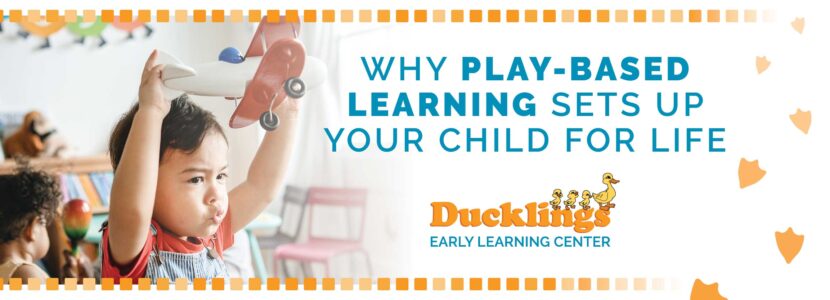
Why Play-based Learning Sets Up Your Child for Life
If you’re looking for daycare centers, you might be seeing the phrase “play-based learning” pop up. Play-based learning is a type of early childhood education based on child-focused learning and open-ended play. If you’re imagining preschoolers finger painting or ‘playing house’, you’re exactly right.
This type of approach is incredibly beneficial for your child for a number of reasons. Here at Ducklings Early Learning Center, we incorporate this into our Whole Child approach.
Why is this important?
Children are naturally wired to do the very thing that will help them learn and grow. According to the NAEYC, “The impulse to play comes from a natural desire to understand the world.”
Through play, children discover how to make decisions and build relationships. Young children are enriched by connecting with others in a stimulating environment, which prepares them for the rest of their lives. They learn best when they are free to explore the things that they find interesting–which can change from one moment to the next.
How is this put into practice?
Play-based learning helps a child develop holistically through social-emotional learning, developing confidence and motivation, and practicing cognitive skills. The academic or traditional approach to early childhood education is more focused on teaching young children cognitive skills and knowledge through structure and routine.
- Self chosen: A child voluntary chooses to play, how they’ll play, and for how long. An adult may initiate play insofar as he or she invites or suggests play but the child determines the rest.
- Enjoyable: Play is enjoyable for the child. This emotional aspect is important.
- Unstructured: A child has ample time to explore and discover during play. They’re directed by their own interests, not by any prescribed rules or plans.
- Process-oriented: There is no end or learning goal. Instead, it’s the process of play that’s important.
- Make believe: Play often involves imagination, ‘make believe’, or ‘playing pretend’. Ducklings’ teachers encourage imagination to help build Thinkers instead of followers.
What makes a good fit?
A quality play-based child care center can be hard to find if you don’t know what you’re looking for. Here are some suggestions of what to look for as you compare your options:
- A program that incorporates the children’s natural interests into the daily flow.
- Both indoor and outdoor play. Our Ducklings have a large gymnasium as well as several outdoor play spaces to explore every day.
- A variety of play spaces available, like dramatic play areas, block building area, and sensory area. Our classrooms have a variety of learning centers so Ducklings can explore on their own time.
- Children get to self-select their play experience and materials.
- Children can play for long periods of time without interruption.
- Children have the opportunity to play with others and to play alone as well. Group play is just as important as solitary play, as they each teach valuable skills.
We know that finding a place for your child is an important decision. We are a NAEYC certified daycare center with a Whole Child approach, encompassing play-based learning. Kids are meant to play and stay curious, which is exactly why we encourage them to do just that.
If you’re searching for a high-quality daycare center near Philadelphia, turn to Ducklings Early Learning Center. Children can look forward to fun, themed enrichment activities, plentiful outdoor playtime, and socialization with their peers. Our well-trained teachers encourage children to explore the world around them with a focus on mind, body, heart, and family. Families can feel confident that students are engaged in an age-appropriate daycare curriculum in a safe, compassionate environment. Our childcare education is well-rounded and has the whole child in mind.
